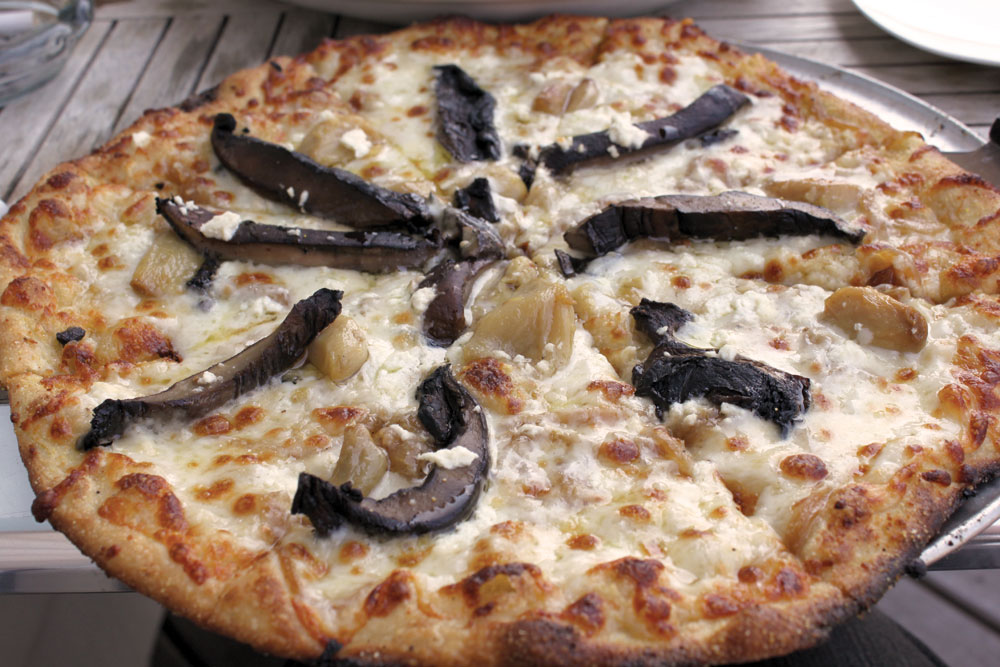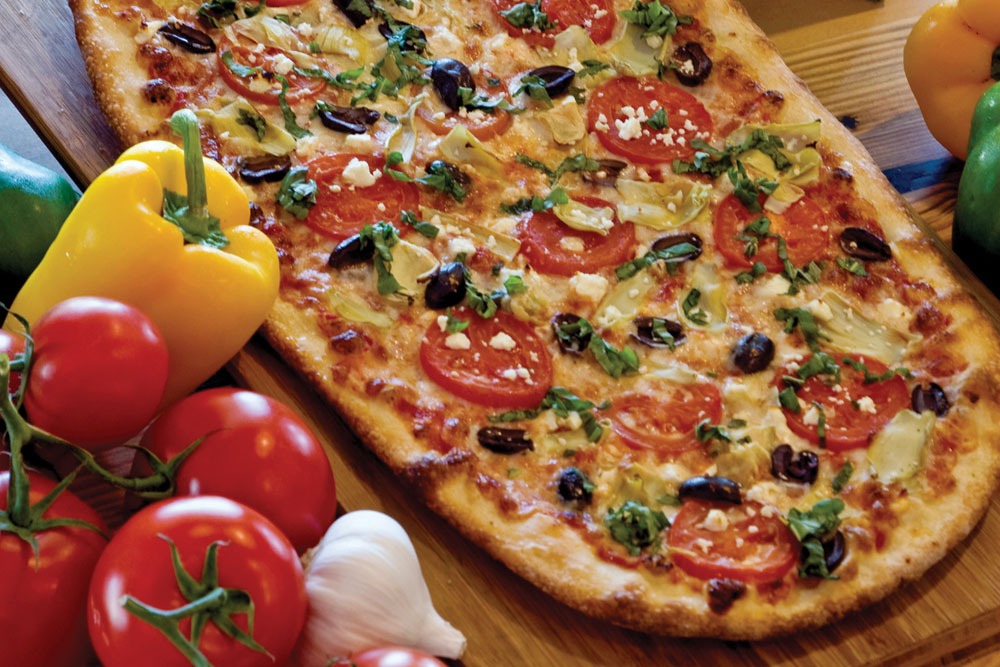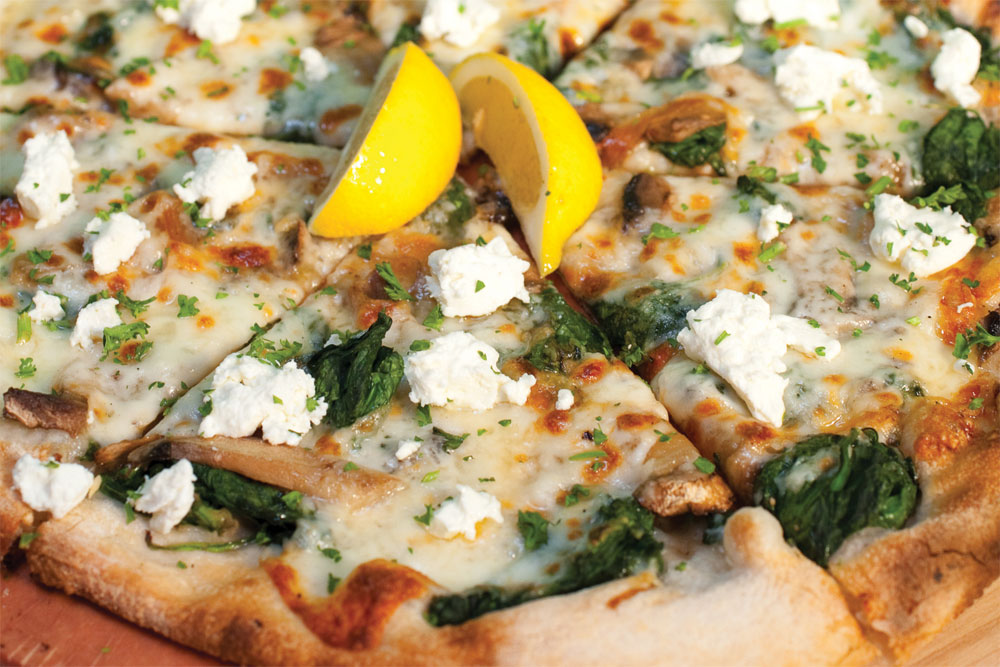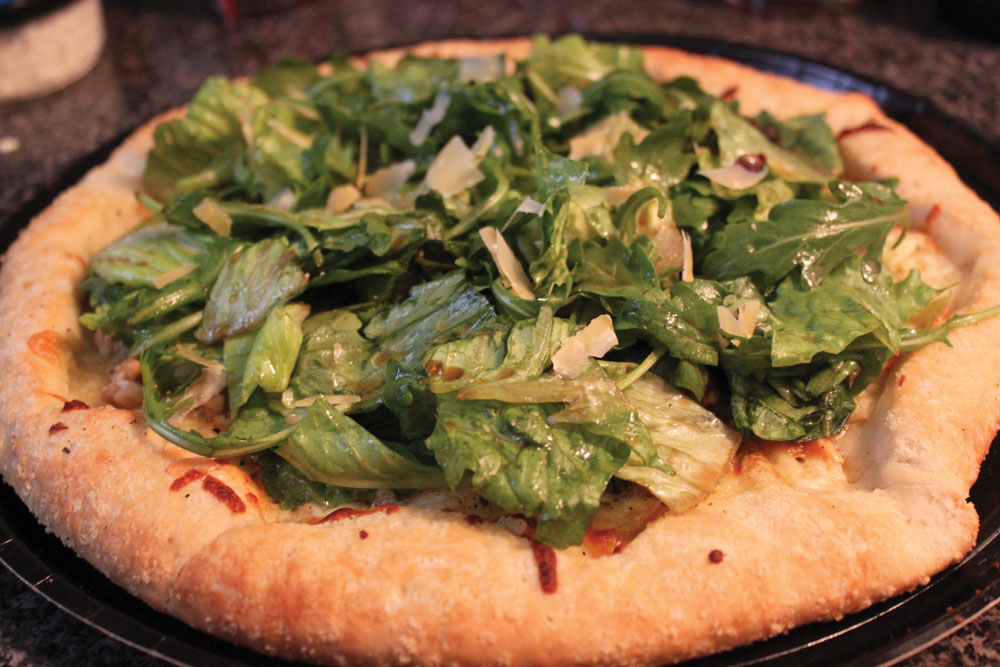Vegetarians aren’t the only ones selecting meat-free meals from menus across the country. Even Mario Batali—known for his pancetta-slinging prowess and old-fashioned mega-meatballs—helped publicize Meatless Mondays a few years back. According to a 2008 study by Vegetarian Times and a 2012 Gallup Poll, 5% to 7% of American adults consider themselves to be vegetarian (including the still-small, but fast-growing, vegan group), while 10% of U.S. adults say they follow a largely vegetarian-inclined diet, and nearly half eat at least one meatless meal per week.
The bottom line: If you’re not actively catering to vegetarians, you’re missing out. Pizza is a natural eating-out option for this segment, since there are plenty of vegetable-based specialty pizzas and the opportunity for design-your-own customization. Chances are, even without making any changes to your core menu, you can do more to woo this group—and, much like gluten-shunning customers, vegetarians make an extremely loyal bunch when they know their needs are being considered.
“Vegetarians and vegans continue to be on the rise in America, and it’s important to have options for them, because they tend to be very passionate and loyal to places that give them options,” says Dan Reed, director of marketing at Chicago Vegan Foods, based in Chicago. “Vegetarians are always on the lookout for new and inventive dishes made with fresh ingredients, and pizza has always been a great food choice for them.”
Take these tips from experts on how you can use menu design, inventive ingredients, staff training and back-of-house tweaks to turn your pizzeria into a haven for those who crave meatless meals.
Mind Your Menu
| Vegetarian Vocabulary |
|
Vegetarians can be split up into subgroups, in ascending order of strictness:
|
Your pizzeria probably already offers the typical vegetarian-friendly pizzas, such as a Margherita or one simply (if not cleverly) called “Veggie” on the menu. But why not try adding a few unique vegetarian toppings or putting some thought into a specialty combination that competitors don’t have? If there’s one thing vegetarians get tired of, it’s the same-ol’, see-them-everywhere vegetarian options on menus, so thinking outside the box will give you an edge. “The most important part about catering to vegetarians is to make sure you do it with authenticity and integrity; don’t throw a few options on your menu simply because you feel obligated to,” advises Vaughan Lazar, CEO of Pizza Fusion (pizzafusion.com), based in Boca Raton, Florida. “Just like carnivores, vegetarians are die-hard food lovers and know good food, so they expect quality and creativity.”
At Lilly’s Pizza (lillyspizza.com), with two locations in Raleigh and Durham, North Carolina, vegetarians have a plethora of options, with half of the menu comprised of meatless items. “We offer 70-plus toppings, including some unique ones, like organic roasted chilies, and just the availability and choices create a community awareness that we’re interested in serving this group,” says owner Jon Garrison. “As a former vegan and vegetarian, I know how difficult it can be finding places that can serve you, so we’ve always catered to them.”
But don’t simply put your vegetarian (or vegan) items on the menu—call them out. A vegetarian customer likes to be able to scan the menu for a symbol (Garrison uses a green “V”) that denotes a meat-free item. Or, if you have a lot of vegetarian options, you can have a special vegetarian menu or a section of the menu that lists all of these items in one place. “Calling out specialty menu items that are vegetarian or vegan is huge,” Reed notes. “Vegetarians are a very vocal group and like to spread the word when they’ve found something special, so having inventive toppings—from dairy-free cheese and mock meats to unique vegetable combinations—is key.”
Finally, if anything on your menu isn’t vegetarian but could be construed as such—say, if you use chicken stock in your marinara—put a note on the menu saying so. Make sure it’s noticeable and placed in a prominent area, such as at the top of the list of your vegetarian pizzas. It’s a vegetarian customer’s worst nightmare to later find out he has unintentionally consumed an animal-based product. Of course, you can avoid this step by clearly marking vegetarian- and vegan-safe menu items outright.
Mock Debate
Some vegetarians have no desire for mock meats, preferring to eat items that have no resemblance in taste or texture to real meat. But a lot of your vegetarian customers will welcome the opportunity to order the range of pizzas their meat-eating friends can get, so consider offering meat substitutes at your pizzeria. Meanwhile, for vegans, you’ll probably want to offer a dairy-free cheese option.
Luckily, there are plenty of meat substitutes on the market—for seafood (crab, tuna, calamari), beef (crumbled hamburger, meatballs), pork (ribs, bacon, pepperoni, sausage), chicken (breaded or “naked,” in cubed, patty, breast or strip form) and more. In fact, even health-conscious meat eaters might choose them over the real thing. “Meatless proteins provide the chef with endless creative possibilities,” says Russell Barnett, vice president of marketing at Gardein in Los Angeles. “They are operationally friendly and can be used as a substitute for beef and chicken in any recipe. A meatlike taste and texture gives the guest all the sensory experiences of eating foods they know and love, often with the nutritional and health benefits of clean, protein-packed, sustainable food.”
When it comes to vegan cheese, Reed suggests finding one that’s tasty and has a great shelf life. “The vegan cheese market has come a long way in the past few years, and more pizza venues are picking up on this, but shelf life of the product is the key to sustainability,” he says. “You may not be serving up a huge percentage of vegan pizzas, but you need to have that option when it arises and still minimize any loss in unused product.” Meanwhile, for mock meats, Reed advises that pizzeria owners look for something that’s not going to dry out too quickly in the high heat of a pizza oven, because vegan items aren’t as fatty as meat-based sausage or pepperoni, for example.
Garrison feels that many mock meats aren’t well-seasoned, so he uses an in-house seasoning blend to infuse flavor. “We get unbreaded mock-meat products because our vegetarian customers might not know what’s inside a breaded product, and it looks like real meat,” he notes. “We also use sauces, like our homemade Thai Curry sauce, to spice up less flavorful ingredients, such as tofu.”
Experiment with the different products on the market and try them out yourself—both on their own and in practical applications. Ask vegetarian or vegan friends for their opinions, or host a vegetarian sampling night to solicit feedback. There has been an explosion of meat and cheese substitutes in recent years, so you’ll need to find what will work best for your customers and recipes. “We always look for high-quality products with good flavor profiles, but you can’t simply offer these products; you have to offer the products people will want to order,” says Cindy Wahl, “marketing chick” at Uncle Maddio’s (unclemaddios.com), a fast-growing build-your-own pizzeria chain based in Atlanta. “One of our most popular offerings in the vegan community is vegan cheese—and not only do we provide it; we don’t upcharge for it. That’s a rarity for this product.”
Finally, feel free to get creative with your vegetarian ingredients. At Pizza Lucé (pizzaluce.com), with seven locations in Minnesota, mock meat is used liberally, as is dairy-free mozzarella and ricotta. Though vegetarians can order familiar faves—such as a “meatball” Parmigiana or a “chicken” sandwich—the pizzeria doesn’t rest on its mock-meat laurels. To wit: The Rustler specialty pie, topped with mock duck, pineapple, banana peppers, red onion, cheddar, mozzarella and barbecue/red sauce, is a testament to the pizzeria’s willingness to put just as much thought into its vegetarian pies as its meat-based selections.
 |
|
At Slice Pizza & Brew (slicebirmingham.com), the White Shadow pizza features garlic, caramelized onion, portobello mushrooms, feta and Parmesan, finished with truffle oil. |
Staff Solutions
To be prepared to field questions from this generally wary group, your front-of-house staff should have a clear idea of how all menu items are prepared—including training on which items often have “hidden” animal-derived ingredients (some top offenders: Caesar dressing, Worcestershire sauce, marshmallows, meat-based stocks and gelatin). “There’s nothing worse than having special food requests, allergies, etc., and asking a server for some help navigating the menu, only to get a confused stare in return,” Lazar says. “And the best way to make a vegetarian feel welcome is to start out with the old saying: ‘How may we help you?’ You might even train staff to ask up front about food allergies or dietary restrictions.”
“Our staff has a comprehensive understanding of all of our food options that meet the needs of our customers with special dietary requests, whether they’re allergy-related or a lifestyle commitment,” says Sara I. Gunter, director of business administration for the three-location D.C.-based Pizzeria Paradiso (eatyourpizza.com). “This understanding starts with our training and testing program prior to their first serving shifts. Our staff’s knowledge of the toppings we offer and the ingredients included in all of our recipes are stressed repeatedly and often.” Pizzeria Paradiso’s staff is also required to participate in in-house continuing education training and intermittent random testing that reinforces the importance of this knowledge—which helps staff adequately meet customers’ needs and demands, says Gunter.
 |
|
Pizza Fusion utilizes creative combinations and fresh vegetable toppings in its successful selection of vegetarian pizzas. |
However, creating good back-of-house habits are equally important. Garrison makes sure to train staff on avoiding cross-contamination of utensils and using separate containers on prep tables so that meat doesn’t touch vegetarian toppings, for example. Though he admits constant vigilance may be required for newer staff members, longtime employees won’t think twice about these efforts, which will gain you a loyal following with vegetarian customers.
“The biggest part is education in regards to cross-contamination and separation,” Reed agrees. “For safety and ethical reasons, you’re not going to want meat and mock meats/veggies or dairy-based and nondairy cheese coming into contact through improper handling or sharing the same utensils.” Reed adds that mock meats can look very similar to their animal-based counterparts, so it’s important to have everything clearly marked and separated. And since building trust with these customers is a top priority, thorough training is a must. Finally, it won’t hurt to include this commitment in writing on your menu and marketing materials—customers usually can’t see inside your kitchen, but they’ll feel better knowing about your painstaking practices.
As far as marketing your new status as a vegetarian and vegan safe haven, you can put the word out through the usual channels—your social media accounts, website, advertising and menus—or offer (as Pizza Fusion does) Meatless Mondays specials on vegetarian and vegan items. But, when you thoroughly follow the steps outlined above, you’ll likely be a beneficiary of the greatest marketing of all—word-of-mouth. “When you get the word out that you care, offer a safe product and are interested in this segment, I think you’ll get people talking,” Garrison says. “And, with vegetarians and vegans, once that word-of-mouth starts, it’ll quickly replicate.”














